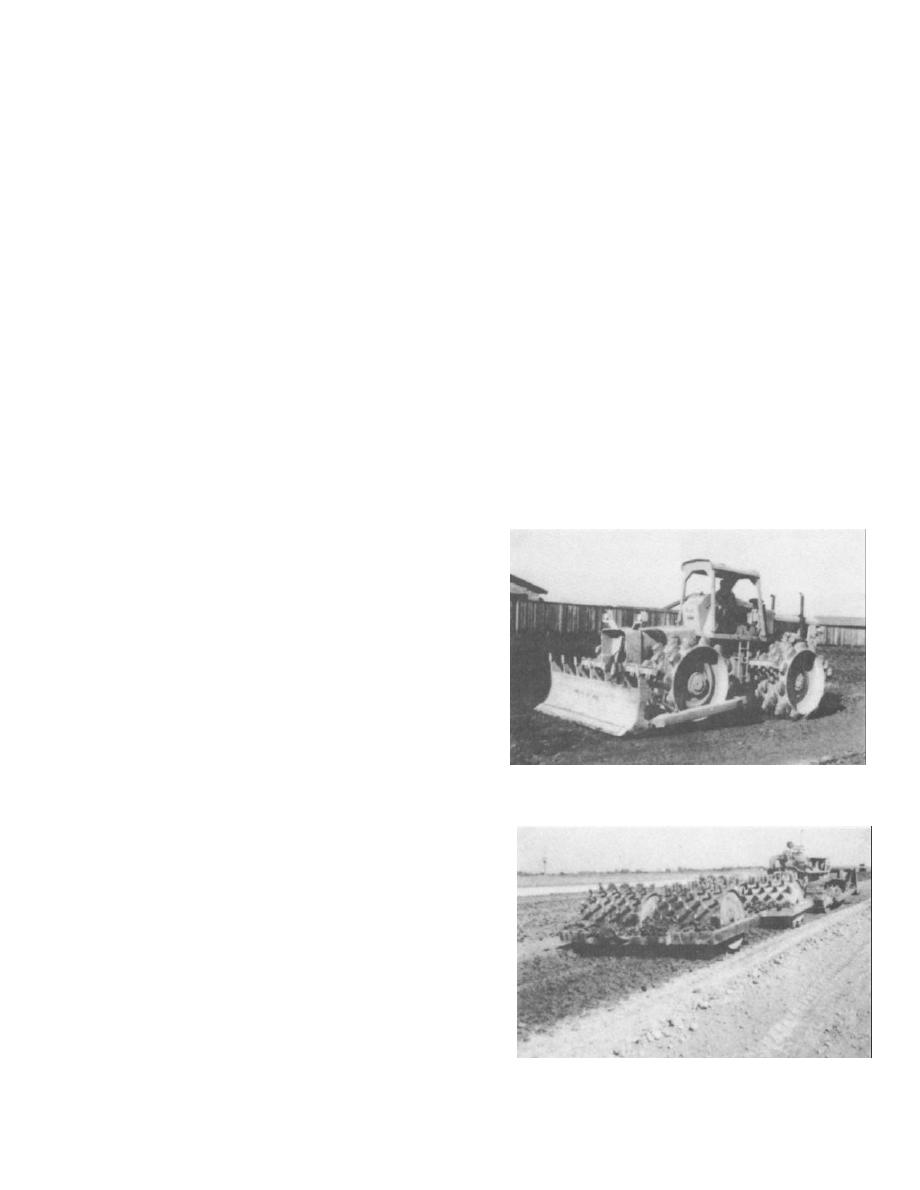
TM
5-822-14/AFJMAN
32-1019
paction can also be accomplished with vibrating
moisture at the pugmill, thereby permitting imme-
impact rollers (fig 4-43) or heavy pneumatic roll-
diate compaction after laydown. Figure 4-22
ers, and light pneumatic or steel rollers used for
shows a crushed-stone plant where lime was added
finishing. When light pneumatic rollers are used
to upgrade a clay bearing crushed stone.
(e) Pulverization and mixing requirements.
alone, compaction is generally done in thin lifts
usually less than 6 inches. Slush rolling of granu-
Pulverization and mixing requirements are gener-
lar soil-lime mixtures with steel rollers is not
ally specified in terms of percentages passing the
recommended. During compaction, light sprinkling
1-inch or 1-inch screen and the No. 4 sieve. Typi-
may be required, particularly during hot, dry
cal requirements are 100 percent passing the 1
weather, to compensate for evaporation losses.
inch, and 60 percent passing the No. 4 sieve,
( 5 ) Curing. Maximum development of
exclusive of nonslaking fractions. However, in
some applications the requirements are relaxed.
strength and durability also depends on proper
For example, the South Dakota Highway Depart-
curing. Favorable temperature and moisture condi-
ment only requires 100 percent passing the 1.5
tions and the passage of time are required for
inch screen with no requirement for the No. 4
curing. Temperatures higher than 40 degrees F to
sieve. Other specifications may only require 40 to
50 degrees F and moisture contents around opti-
50 percent passing the No. 4 sieve. In certain
mum are conducive to curing. Although some
expedient construction operations, formal require-
specifications require a 3- to 7-day undisturbed
ments are eliminated and the "pulverization and
curing period, other agencies permit the immedi-
mixing to the satisfaction of the engineer" clause
ate placement of overlaying paving layers if the
is employed.
compacted soil-lime layer is not rutted or distorted
(4) Compaction. For maximum development of
by the equipment. This overlying course maintains
strength and durability, lime-soil mixtures should
be properly compacted. Many agencies require at
least 95 percent of ASTM D 698 density for
subbase and 90 percent for bases. Some agencies
have required 95 percent ASTM D 1557 maximum
density. Although such densities can be achieved
for more granular soil-lime mixtures, it is difficult
to achieve this degree of compaction for lime-
treated, fine-grained soils. If a thick soil-lime lift is
to be compacted in one lift, many specifications
require 95 percent of ASTM D 698 maximum
density in the upper 6 to 9 inches, and lower
densities are accepted in the bottom portion of the
lift. To achieve high densities, compacting at
approximately optimum moisture content with ap-
propriate compactors is necessary. Granular soil-
lime mixtures are generally compacted as soon as
Figure 4-40. Self-propelled sheepsfoot roller.
possible after mixing, although delays of up to 2
days are not detrimental, especially if the soil is
not allowed to dry out and lime is not allowed to
carbonate. Fine-grained soils can also be com-
pacted soon after final mixing, although delays of
up to 4 days are not detrimental. When longer
delays (2 weeks or more) cannot be avoided, it may
be necessary to incorporate a small amount of
additional lime into the mixture (0.5 percent) to
compensate for losses due to carbonation and
erosion. Various rollers and layer thicknesses have
been used in lime stabilization. The most common
practice is to compact in one lift by first using the
sheeps-foot roller (fig 4-40 and fig 4-41) until it
"walks out," and then using a multiple-wheel
pneumatic roller (fig 4-42). In some cases, a flat
Figure 4-41. Dougle sheepsfoot roller.
wheel roller is used in finishing. Single lift com-
4-19


 Previous Page
Previous Page
